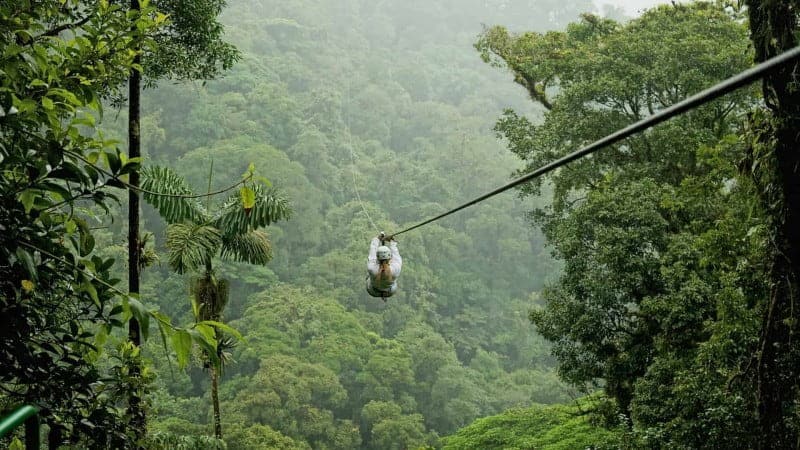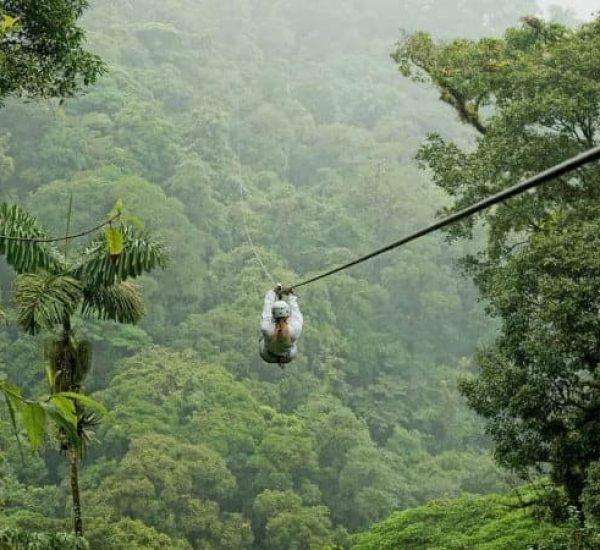explore costa rica
Costa Rica Rainforests
Don't forget to book your vacation rentals with us
About Costa Rica Rainforests
Despite being such a small country, Costa Rica is one of a handful of locations with rainforests, particularly tropical rainforests which are the most biologically diverse terrestrial ecosystems in the world.
About 51% of Costa Rica’s territory is rainforest, and almost 24% of this is primary forest, meaning perfectly immaculate lush vegetation that has not been affected or distorted by humans.
Rainforests cover a small percentage of the earth’s surface, about 6%, however, they are home to more than half the species of flora and fauna on the planet.
RELATED: Costa Rica’s Rainforest: How The Country Managed To Restore It
Types of Rainforests in Costa Rica
Costa Rica is home to 3 different types of rainforest, each with its own unique charm. Below is some basic information to help you fall in love with them all.
Tropical Rainforests
Misty rainforest in Costa Rica
Monkey in the jungle of Costa Rica
Keel-billed toucan
Beautiful creek in the rainforest
Hanging bridge through the rainforest
Costa Rica’s tropical rainforests are located in the lowlands (coastal plains) of the northern and Caribbean coast, along with those of the central and southern Pacific as the main regions. Upala, located in San Carlos, and the upper parts of the Nicoya Peninsula are representative as well.
Tropical rainforests are called the “gems of the Earth” and the “world’s biggest drug store,” since more than 33% of natural medications have been found here. It is an earthly environment with an exceptional abundance of creatures and plants (in amount and variety) living in perfect balance.
Climate
Costa Rica’s tropical rainforest covers 5.5% of its territory. It is an amazing biological system and a magical sanctuary full of life, shapes, colors, sounds, and aromas. Thanks to constant rainfall and an average of 200 inches of rain per year due to its location, Costa Rica’s rainforests are evergreen.
Max temperature reaches 91.4º F (33 ºC) and Min 71.6º F (22 ºC).
Animals
Some of the most typical examples of animal life found in Costa Rica rainforests are green basilisk, green iguana, two-toed sloth, three-toed sloth, red-eyed frog, howler monkey, spider monkey, coati, puma, jaguar, ocelot, among others. The large number of exotic birds living there is impressive, as are the butterfly and reptile species.
Plants
Vegetation is represented by bromeliads, mosses, lichens, and orchids, as well as countless trees such as laurel, caobilla, coral oak, golden fruit, ojoche, cedro maría, and botarrama, just to name a few.
The most visited tropical rainforests in Costa Rica are inside National Park areas such as: Manuel Antonio National Park, Corcovado National Park, Cahuita National Park, Carara and Piedras Blancas National Park.
Book Your
Costa Rica Vacation
Cloud Forests
Clouds settling in on the mountains
Clouds touching the
treetops
Looking up through a cloud forest
Monteverde hanging bridges are popular for hikers
Costa Rica’s cloud forests are mainly located in the Cordillera de Tilarán, more strictly between Monteverde and the Arenal Volcano; there are also some cloud forests in the Cordillera de Talamanca.
As the name suggests, these types of forests are known for having cloudy conditions and almost 100% humidity throughout the year. They are located in the highest parts of the mountains of Costa Rica and in some of the volcanoes.
These forests are usually covered by a thin layer of clouds and bathed in a light drizzle, giving visitors the sense of being close to touching the sky.
Immersion in the clouds for long periods of time is what shapes the architecture and species composition of the cloud forest. They generally have an abundant cover of mosses, evergreen vegetation, and rich biodiversity.
Just 1% of the worldwide woodland area is comprised of cloud forests, making them extremely rare. It is estimated that around 50% of Costa Rica’s biodiversity can be found there, an impressive 2.5% of the total world biodiversity.
Climate
The hottest month is April with an average temperature of 74° F (23° C), while the coldest month is February with an approximate temperature of 57° F (13.88° C).
Animals
A total of 425 bird species, 68 bats, 6 felines, foxes, sloths, armadillos, and numerous amphibians and reptiles have been recorded in Costa Rica’s cloud forests.
Some of the animals, especially tropical birds, do not live permanently in the forest, but come looking for fodder for their nests, and then leave. However, many of the species in this ecosystem are rare and are not found anywhere else in the world.
A few birds found here are: Emerald Toucan, Black Guan, Redstart, Bobo Bird, and half a dozen of dazzling hummingbird species, to name a few. Mammals such as Kinkajú, Hoffmann Sloth, pacas, pumas, and many more are also some of the cloud forest hosts.
Plants
Costa Rica’s cloud forest is home to more than 755 species of trees, 2,500 plant species of which only 420 are orchids. There are more than 358 kinds of ferns, some of which grow to incredible sizes that can even be mistaken for tall trees. There are about 40 or 50 species of fruit trees (to put things into perspective there are about 60 distinct types of avocado trees). Absolutely mind-blowing!
Some of the most representative cloud forests in Costa Rica are Monteverde, San Gerardo de Dota, Cerro de la Muerte, Talamanca and Chirripó, to name a few.
Tropical Dry Forests
View of the Rio Tempisque
Prairie in Guanacaste
Hiking in Guanacaste National Park
Tropical dry forests are located in Guanacaste province from the Tempisque valley, north to the border with Nicaragua and south to the mouth of the Tárcoles River.
Compared to the previous two types of rainforests in Costa Rica, the tropical dry forest gets significantly less precipitation. It is one of the most vulnerable Costa Rica rainforests and one of the rarest in Central America.
Climate
The tropical dry forest is full of contrasts; during the dry season (from December to April) trees change their leaves for flowers, forming a natural rainbow in the treetops, then the rainy season (May to November) gives way to life when new leaves are born, allowing visitors to see a green forest with characteristics similar to those of other humid forests.
Max temperature reaches 91.4º F (33 ºC) and min 71.6º F (22 ºC).
Animals
Among the most common animal species living in the tropical dry forest, there are howler monkeys, white-tailed deer, coyote, owl, woodpecker, agoutis, trogons, tortoises, hawks, butterflies, parakeets, among others.
Plants
Trees like espavel, guanacaste (Costa Rica’s national tree), cenízaro, and guapinol can be easily spotted and many shrubs and ground plant species.
The national parks that contain dry forests are Guanacaste National Park, Rincon de la Vieja National Park, Santa Rosa National Park, and Palo Verde National Park.
Book Your
Costa Rica Vacation
Visiting the Rainforests in Costa Rica
What to Expect
In simple words, expect to be blown away by the most extraordinary biodiversity on the planet!
Magnificent views, more flora and fauna that you can count and the purest air you can breathe are just a few of the wonderful experiences that await you at any of Costa Rica’s rainforests.
Take into consideration that Costa Rica has two seasons: the rainy season that goes from May to November, (being October the rainiest month), and the dry season from December to April.
Essentials to Bring
First of all, make sure to bring protection items such as:
- sunblock
- mosquito repellent
- sunglasses
- hat
- face mask
Secondly, bring clothes that will make your journey comfortable and won’t restrict your adventure:
- sturdy hiking shoes or well-built sneakers
- water shoes
- pants
- long sleeve shirts
- rain jackets or ponchos
Also, don’t forget to bring a waterproof phone case, as you will want to take as many photos as possible with or without rain.
Things to Do in the Rainforest
You have a wide variety of activities in Costa Rica to choose from while visiting these tropical forests including bird watching, wildlife exploration, white water rafting, hiking trails, kayaking, canopy, ziplining, mountain biking, horseback riding, and canyoning (rappelling down waterfalls), among others.

As you can see, you will never have a dull moment in any of these magical rainforests.
Whether sitting at some high point in the cloud forest, feeling you can touch the sky while watching the majestic flight of the impressive resplendent quetzal; to being immersed and surrounded by jaw-dropping trees in a tropical rainforest; one thing is for sure, you will never experience more closeness to mother nature anywhere else but in Costa Rica’s rainforests.
Other Attractions
After you have visited volcanoes and national parks you may want to observe (or cool off in) some of the many beautiful waterfalls while in Costa Rica. Be sure to view our full list of things to do in Costa Rica to ensure you’re experiencing all of the main attractions while on your vacation.
FAQs
Frequently Asked Questions
About Rainforests
An impressive 51% of Costa Rica is covered by rainforest.
